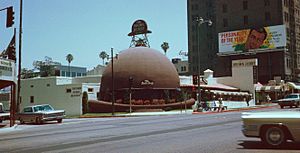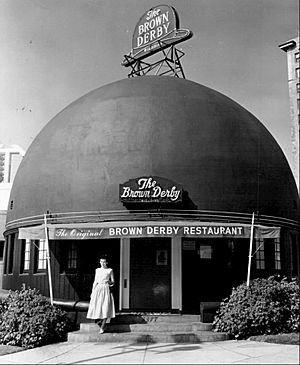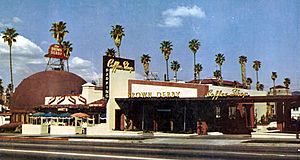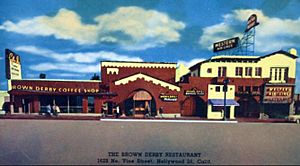Brown Derby facts for kids
Quick facts for kids Brown Derby |
|
|---|---|

The original Brown Derby on Wilshire Boulevard in Los Angeles, California, c. 1968
|
|
| Restaurant information | |
| Established | 1926 |
| Previous owner(s) | Wilson Mizner |
| Food type | American |
| Dress code | Formal |
| Country | United States |
The Brown Derby was a famous group of restaurants in Los Angeles, California. The very first and most well-known one was shaped like a giant derby hat. This unique building became a symbol of the exciting "Golden Age of Hollywood," a time when movies were becoming hugely popular.
The first restaurant opened in 1926, started by Wilson Mizner, Robert H. Cobb, and Herbert K. Somborn (who used to be married to movie star Gloria Swanson). The original Brown Derby restaurants eventually closed or changed their purpose by the 1980s. However, the brand has been brought back to life in the 21st century with new restaurants, thanks to The Walt Disney Company. Many people mistakenly think there was only one Brown Derby restaurant, and they often confuse the ones on Wilshire Boulevard and in Hollywood.
There's also a different group of steakhouse restaurants called "Girves Brown Derby." These were started in 1941 in Ohio and are not connected to the famous Hollywood chain.
Contents
Wilshire Boulevard Brown Derby
The First Hat-Shaped Building
The very first Brown Derby restaurant opened in February 1926 on Wilshire Boulevard. It was built in the fun and eye-catching shape of a derby hat. This kind of whimsical architecture was popular back then, designed to grab the attention of people driving by. The restaurant's name came from another "Brown Derby" restaurant in New York that was a popular spot for performers.
This first Brown Derby was a small cafe, located across the street from the famous Cocoanut Grove nightclub at the Ambassador Hotel. Wilson Mizner was the public face of the restaurant, while Herbert K. Somborn owned the land, and Jack L. Warner (from Warner Bros. Studios) provided the money. Wilson Mizner often sat in his favorite booth almost every day. The restaurant was small and had a funny problem: sounds from one side of the room would bounce off the curved ceiling and travel to the other side!
What Happened Next
The original hat-shaped building was taken down in May 1936. The land was used to expand a nearby hotel. Later, in 1967, that hotel was replaced by a large office building.
A New Wilshire Location
In 1936, a bigger building, also shaped like a hat, was built nearby on Wilshire Boulevard. The restaurant moved into this new home in May of that year.
In the 1947 cartoon Fun and Fancy Free, the giant character Willie the Giant stomps through Hollywood looking for Mickey Mouse. Willie sees the Brown Derby restaurant, thinks it looks like a hat, and puts it on his head before walking away!
In September 1980, this Brown Derby restaurant suddenly closed. People who wanted to save old buildings worked hard to stop it from being destroyed. They convinced the developers to carefully remove and save the derby hat part of the building. The rest of the restaurant was torn down and replaced with a shopping center. The famous hat-shaped structure was then placed on the roof of the new building.
What's There Now
The area where the restaurant used to be is now a shopping center called the Brown Derby Plaza. The saved hat-shaped dome is still there, on the third floor of the building. It used to be a Korean bar but is now empty.
Hollywood Brown Derby
The second Brown Derby opened on Valentine's Day in 1929 on Vine Street in Hollywood. Even though it didn't look like a hat, this location became very important in Hollywood history. Because it was so close to the movie studios, it became the perfect place for movie deals and for celebrities to see and be seen.
It's said that actor Clark Gable asked Carole Lombard to marry him there. Famous gossip columnists Louella Parsons and Hedda Hopper were also regular customers.
In an episode of I Love Lucy called "L.A. at Last," Lucy (Lucille Ball), Ethel (Vivian Vance), and Fred (William Frawley) have lunch at the Brown Derby. In a funny scene, they sit near Eve Arden and William Holden (who orders a Cobb salad). Lucy accidentally causes a waiter to hit William Holden in the face with a pie!
Like the Wilshire Boulevard location, the Hollywood Brown Derby had a "celebrity wall" covered with hundreds of drawings and funny pictures of famous people. Many of these were drawn by artists like Jack Lane and Nicholas Volpe.
The Hollywood Brown Derby is also famous for being the birthplace of the Cobb salad. The story goes that owner Bob Cobb quickly made the salad from leftovers for a showman named Sid Grauman. It was chopped into small pieces because Mr. Grauman had just had dental work and couldn't chew well.
According to actress Shirley Temple, the non-alcoholic drink named after her, the Shirley Temple, was created at the Brown Derby in the mid-1930s. However, Shirley Temple herself never liked the drink and said her name was used without her permission.
The Hollywood Brown Derby closed its doors for good on April 3, 1985, because of a disagreement over its lease. After it closed, the building was damaged by a fire in 1987. Then, the 1994 Northridge earthquake caused even more damage, and the building was declared unsafe. It was torn down the next month.
What's There Now
After the original building was torn down, a new restaurant and bar called Premieres of Hollywood opened there. It tried to capture the feeling of "Old Hollywood." This restaurant was later destroyed during the Los Angeles riots in 1992. Today, the land where the Hollywood Brown Derby once stood is an apartment complex.
Later Brown Derby Restaurants
After the original Hollywood Brown Derby closed in 1985, there were attempts to open new Brown Derby restaurants in other locations. Walter P. Scharfe, who owned the chain, opened new restaurants in Pasadena and another in Hollywood. These new places tried to bring back the old feel with dark booths and celebrity caricatures. He even planned to open more in other cities. However, these new restaurants closed after a short time. In 1994, another small Brown Derby opened in a shopping mall, but it also closed in less than a year.
Beverly Hills Brown Derby
Bob Cobb opened the third Brown Derby in 1931 in Beverly Hills, across from the Beverly Wilshire Hotel. One of its dining rooms, called The American Room, had charcoal portraits of actors who had won Academy Awards. This Brown Derby was special because it had the first revolving door in Beverly Hills and a doorman in a uniform. It closed in 1982 and was soon torn down.
Los Feliz Brown Derby
The building that used to be the Los Feliz Brown Derby has been a restaurant since the 1920s. Movie producer Cecil B. DeMille, who was part owner of the Wilshire Blvd. restaurant, bought the building and turned it into a Brown Derby in 1940. It was unique because it had both a fancy restaurant with a domed ceiling and a more casual drive-in cafe outside.
What Happened Next
In 1960, the building became a restaurant called Michaels of Los Feliz. In 1992, it was changed into a nightclub called The Derby. In the late 1990s, this club became a very popular spot for the return of swing dancing. Many modern swing bands, like Big Bad Voodoo Daddy, became famous there. The band Cherry Poppin' Daddies even recorded a song called "Brown Derby Jump" about the place.
In 2004, when a company bought The Derby and nearby land to build apartments, many people who wanted to save old buildings fought against the plan. On May 19, 2006, the Los Angeles City Council voted to make the entire building an official Historic Cultural Monument, protecting it from being torn down.
In January 2009, the nightclub closed. Today, the Los Feliz Brown Derby building is home to a restaurant called Mess Hall Kitchen and a Chase bank. The dome is now split between the two businesses, and you can see the inside structure of the dome from the restaurant.
Brown Derby Crenshaw Center
A fifth Brown Derby opened in 1955 at the Broadway Crenshaw Shopping Center (now called the Baldwin Hills Crenshaw Plaza) in Los Angeles. It was a coffee shop that was open 24 hours a day. This location later became one of the first International House of Pancakes restaurants.
Licensing Program
The Brown Derby started a program in 1987 to allow other companies to use its name and style. The The Walt Disney Company was the first to do this, creating a copy of the original Hollywood Brown Derby restaurant at the new Disney's Hollywood Studios in Florida. Later, Disney opened similar Brown Derby restaurants at Disneyland Resort Paris, Tokyo Disney Sea, and Disney California Adventure Park in California. The Brown Derby name was also used at the MGM Grand Las Vegas in Nevada and the MGM Grand Detroit in Michigan.
Images for kids







